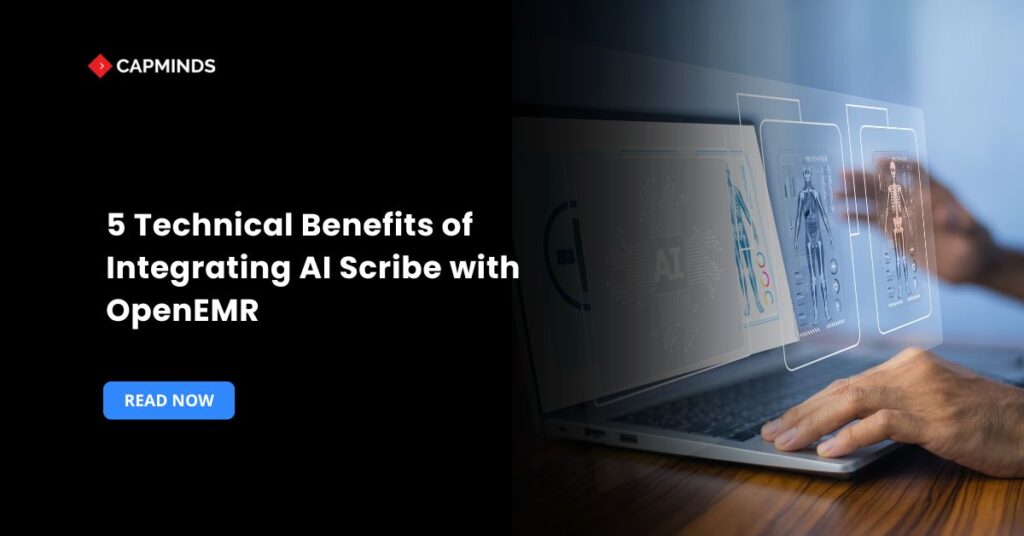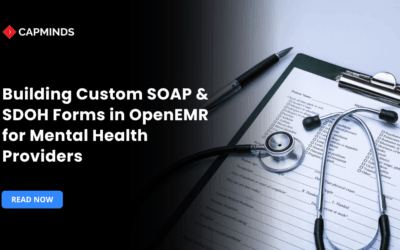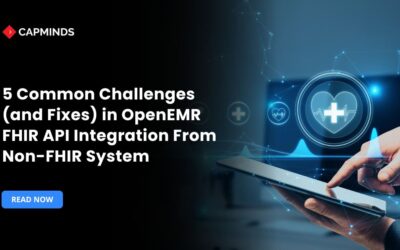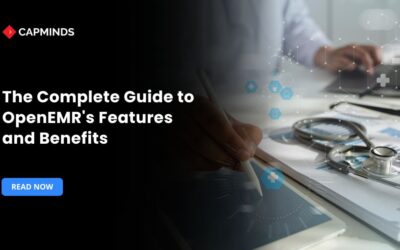5 Technical Benefits of Integrating AI Scribe with OpenEMR
In OpenEMR, healthcare providers face challenges due to manual data entry, which causes a high risk of errors and leads to a time-consuming process. This increases the administrator’s workload, which affects patient care. To reduce providers’ burden, integrating an AI scribe with OpenEMR will improve data accuracy and enhance patient interactions.
Compared to manual scribing, AI scribes have more benefits and minimize the workload. In this blog, you’ll learn about the technical benefits of integrating AI Scribe with OpenEMR.
What is AI Scribe in Healthcare?
An AI Scribe is a tool that automates the documentation process using artificial intelligence. It transcribes the conversation between providers and patients into structured notes.
This helps both clinicians and patients with follow-up information. It reduces the time spent on the clinical documentation process, which allows us to focus on quality patient care.
- AI scribes integrate, capture, and transcribe conversations into documents.
- Automating medical documentation processes will free up providers by improving workflow efficiency.
- Real-time transcription notes can be added to patient medical records for future use.
- Most of the AI scribes are designed for workflows, which allows automatic integration of notes.
- Using NLP speech recognition ensures accurate transcription by reducing the risk of errors.
Technical Benefits of Integrating AI Scribe with OpenEMR
1. Automated Medical Documentation Using NLP
Integrating an AI Scribe via natural language processing to convert voice into structured clinical notes.
Real-Time Speech to Text Transcription
- Speech recognition engines capture provider-patient conversations or dictations using ASR transformer models.
- Transcription pipelines are optimized for medical vocabulary using custom language models.
- The audio is sent to an AI scribe service, which returns text snippets.
Entity Recognition and Structured Data Extraction
- Named entity recognition recognizes drugs, doses, diagnoses, treatments, allergies, and more.
- Connecting recognized entities to OpenEMR fields such as issue list items, update diagnoses, and pharmaceutical entries, fill up the medicine module.
- Standardizes terminology using ontologies like SNOMED CT, RxNorm, and ICD-10. Normalization logic or external terminology services must be incorporated into the AI Scribe.
Template and Note Generation
- Based on the patient encounter type, such as new patient or follow-up, the AI scribe applies the appropriate note templates, including SOAP and History & Physical examination.
- Providers can adjust the prompts, such as for orthopedic exams, to capture physical findings with the correct structure. Maintaining configuration files in the integration layer.
Error Handling
- Implementing review workflows through draft notes saved in OpenEMR in pending status for review. Providers can track the scores; if lower, it is flagged for manual correction.
- Audit trails are conducted for quality metrics using recorded original audio, intermediate text, and final notes for compliance.
2. Data Consistency and Standardization
Vocabulary and Terminology Services
AI scribe turns common terms into medical terms via terminology servers or libraries. It ensures consistency for reporting, decision support, and generates billing codes.
Code Suggestion
- AI scribes suggest ICD, CPT, and SNOMED codes from the data extracted. After entity extraction, the API calls the coding-assistance module, and recommended codes are returned alongside the notice.
- Technical requirements include code set versioning and regular code database updates in the AI Scribe engine or via a microservice.
Template and Field Validation
- Fill out discrete fields in OpenEMR like vitals and system reviews rather than leaving them blank.
- Front-end integration of the note editor in OpenEMR displays discrete fields supplied by AI Scribe for inspection.
- Validation criteria include data kinds such as numeric vitals within realistic ranges and obligatory fields that must be filled out before signing the memo.
Metrics and Reporting
- Collect quality-of-documentation measures such as completeness ratings, missing fields, and incorrect terminology usage.
- Integrating output logs or summary reports to analytics modules so that administrators may monitor, retrain, or alter AI models if drift occurs.
Related: Speed Up Documentation with AI and Voice-to-Text: A Guide for OpenEMR LBF Forms
3. Workflow Efficiency and Scalability
Smooth integration reduces manual workload and supports scaling across many users.
API-driven Architecture
Use RESTful APIs so that OpenEMR triggers when the uploads the audio to the AI scribe endpoint. AI scribe returns structured JSON. AI scribes run as a standalone service, as the integration layer handles authentication and queuing.
Load Balancing & Auto Scaling
If AI Scribe is self-hosted, install it in containers/orchestrators like Kubernetes to allow for horizontal scaling during peak loads. Monitor metrics (CPU/GPU utilization, latency) to automatically scale transcription nodes.
Reduces Time on Documentation Process
Clinical notes are completed faster, allowing providers to spend more time with patients rather than typing. Compare metrics before and after average note completion times; integration should keep timestamps for ROI analysis.
Fallback and Offline Modes
In scenarios with intermittent connectivity, enable local caching: record audio locally and queue upload until connection is restored. Locally implement lightweight inference for basic transcribing, then refine on the cloud when available.
4. Enhanced Interoperability and Integration with OpenEMR
Data Exchange Based on Standards
- When OpenEMR supports FHIR, it uses its resources to exchange structured data. AI Scribe, for instance, produces DocumentReference or FHIR DiagnosticReport.
- Map AI Scribe output to OpenEMR’s internal APIs or use clear interfaces to write directly to the database if the OpenEMR version does not support complete FHIR.
Security and Authentication
- OAuth 2.0 or API keys with scopes restricted to transcribing services are examples of secure API requests. Encrypts data both at rest and in transit.
- Make sure that access controls are in place so that only approved people or applications may access created notes or launch AI Scribe.
- Audit logging tracks user IDs, timestamps, and the purpose of each transcription request and answer is recorded.
Integration with Auxiliary Modules
- Billing AI scribe extracts procedures and duration that feeds coding modules to automate charge capture.
- Findings are structured and trigger CDS rules in OpenEMR. Reporting and Analytics feeds structured encounter data into dashboards for population health.
Versioning and Compatibility
Track the versions of OpenEMR and AI Scribe API use semantic versioning for integration components. Maintains backward compatibility or migration scripts.
Extensibility
- Provide OpenEMR hooks that function similarly to plugins, such as triggering further AI-driven actions, such as creating patient education materials or summarizing notes for referrals following note sign-off.
- To enable additional services to subscribe to finished transcription events, use webhooks or event-driven architecture.
5. Advanced Analytics and Ongoing Enhancement
Utilizing AI Scribe data for more extensive technical benefits beyond simply creating notes.
Combined Information for Model Improvement
Gather data from real-world encounters with the proper consent and de-identification to increase the accuracy of language models. Create pipelines to distribute new models, feed into training procedures, and anonymize PHI.
Dashboards for Quality Metrics
Monitor turnaround time, clinician changes needed, and transcribing correctness via spot audits. Utilize these metrics to enhance language models, retrain NER, and modify NLP components.
Alerts & Predictive Analytics
- Examine structured data over time to identify trends, such as an increase in symptom mentions, to initiate preventative measures.
- Incorporate an analytics engine for cohort analysis (e.g., Python-based ETL pipelines flowing into a data warehouse).
Patient Engagement
- Create summaries of structured data that are easy for patients to understand and distribute them through a patient portal.
- OpenEMR’s portal module receives structured findings from AI Scribe, while the transformation service generates summaries in layman’s terms.
Security and Identifying Anomalies
Monitor AI Scribe API usage trends to spot odd spikes or illegal access attempts. To identify possible breaches or misuse, employ SIEM integration or log analytics.
Feedback and User Personalization
- Give doctors the ability to edit AI-generated information, then feed the changes back into the system to increase accuracy going forward.
- Add “edit tracking” to the OpenEMR note editor; transmit metadata to model retraining pipelines; and record the difference between the AI draft and final note.
Related: How AI-Powered Drug Interaction Alerts Enhance Patient Safety in OpenEMR
CapMinds OpenEMR Customization and Integration Service
CapMinds OpenEMR equips clinicians with the best features and ways to integrate. It makes their workflows more efficient and filtered.
The integrated features will allow them to combine the ability of patient record management with conceptual and concurrent reminders.
This enhances the process of decision-making and improves patient care and quality.
- At CapMinds, OpenEMR custom solutions are developed with much care and accuracy to match the special practice needs.
- It will be low-cost and the perfect budget solution for your practice’s long-term future.
- CapMinds OpenEMR prioritizes secure data management & ensures compliance with industry regulations, offering healthcare providers peace of mind.
Get the best technologies and HIPAA-compliant and efficient OpenEMR from CapMinds that can be tailored to fit your practice.
Our OpenEMR services facilitate a Modern User Interface (UI), customization, production support & training. It also facilitates billing, reporting, specialty enhancements, clearing house integrations, e-prescribing, cloud, and more.
“Get the most experienced, proven, and perfect professional support for your OpenEMR.”




